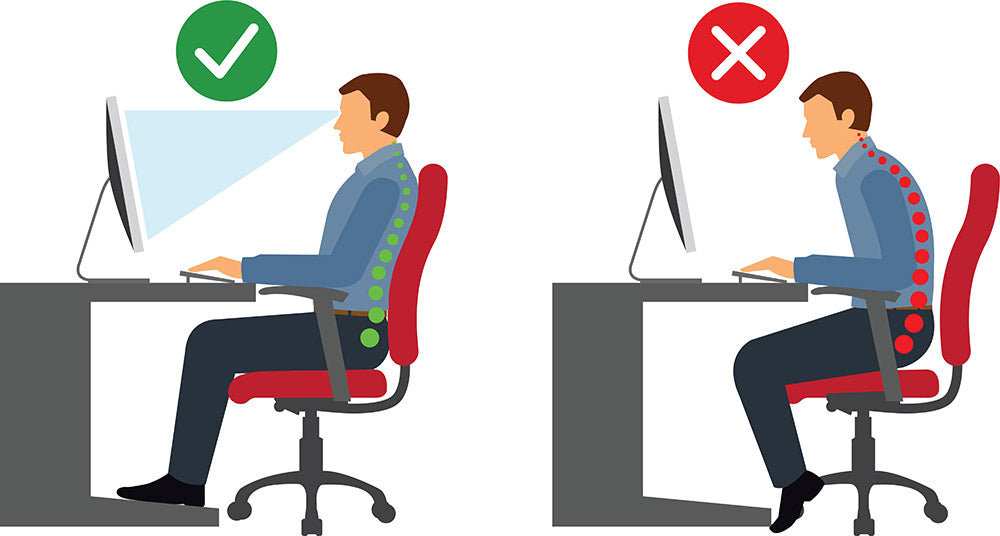How To Maintain Good Posture
March 28 2023 – Nysh Website

We’ve always been told to “keep those shoulders straight”, but not many of us do so. We rarely pay attention to our posture as we think it’s an area we can take for granted. Plus, what we don’t realize is that bad posture leads to many life-altering health problems. All we need to do is maintain good posture so that we stay healthy for ourselves and the people around us. Keep reading to learn how to maintain good posture.
What Is Posture?
Posture goes beyond just standing straight and looking confident. Having good posture is making sure that you are holding your body in the right way, whether you are engaged in any physical activity or just sitting still. That’s how we define what good posture is.
It’s important to know the types of posture so that you’re aware of which one to correct. Posture can be classified into two types.
- Dynamic Posture: The manner in which you hold yourself while moving is termed dynamic posture. Dynamic posture is defined much more broadly as activities that involve your muscles working together to adapt to changes. Some instances of this type of posture include walking, running, or even bending to pick something up.
- Static Posture: We call a posture static when there’s no physical movement involved. Activities such as sitting, standing, and sleeping would be classified as static posture. What happens behind a static posture is that our muscles work in unison to counter gravity and balance our structure.
To ensure that you have a healthy spine, you need to pay keen attention to your dynamic and static postures.
Tips On How To Maintain Good Posture
We can learn how to maintain good posture by rectifying our bad posture habits. Once you have spotted your bad posture type, you’ll have to make some adjustments to see that you’re in good posture. Of course, it’ll be a bit uncomfortable at first, but persevere and try them. These minor adjustments will reap huge health benefits for you.
Sit Up Straight In Your Chair
If you work at a desk job, you'll be familiar with your sitting posture going off the rails as a result of slouching. The habit of slouching in a chair isn’t only restricted to office goers, but also those in general. We often slouch while sitting at a party, or while having a conversation with a friend in the cafeteria. You might not always feel discomfort while slouching, but as time progresses, your muscles and tissues will bear the brunt of all the strain.
You need to sit properly to counter this slouching habit. Your muscles will learn the correct posture as you make the effort to sit properly. When you go to sit, remember to sit straight so that your back is erect. Evenly distribute your body weight on both hips, and make sure that your buttocks are touching the back of your chair.
Another important point to note is the height of the chair you're using. Your feet should comfortably reach the bottom of the floor so that your straight-back position is maintained.
Lean On Both Legs When Standing
You might think that it’s normal to stand on one leg and feel comfortable in this position too. But in reality, standing on one leg can be detrimental to maintaining good posture. What you're doing is allowing the pressure to fall on your lower back and hips to keep you supported instead of your core muscles and buttocks. If this is done often, then the muscles around the pelvis area bear all the strain, causing muscle imbalances that result in lower back pains.
However, there is a simple fix to this bad posture. All you need to do is ensure that your weight is properly distributed on both legs. In other words, you need to stand on both feet! If you still feel the need to correct this posture, you can do exercises like planks and bridging so that your core muscles are strengthened.
Avoid An Incorrect Posture While Texting
You may or may not be aware of your hunching posture if you spend a lot of time over the keyboard of your computer. While using the keyboard, you unknowingly adopt this forward-head posture that affects the spine. The same goes for mobile users who are constantly using their phones for long hours while having their heads in a forward position and that’s how the term “text neck” came into being.
Those with text next will constantly complain of upper back issues since this posture targets that region, leading to shoulder and upper back stiffness.
Exercises such as seated rows and neck posture drills, mainly those that target the upper back, are recommended. Just a word of caution: visit your doctor before performing any of them.
Ensure Lumbar Support For Your Back
After a long day of work, we prefer to unwind in front of our screens on the couch. Without regard for our posture, we tend to be there for hours together binging on our favorite dramas before calling it a night. But this habit, which could seem harmless, could have bad implications for our health.
Slumping in our couches with improper posture for too long leads to complications like a flat back and rounded shoulders (misalignment of the shoulders). A flat back is caused when we sit at the edge of the seat, causing us to sit on our tailbones instead of our buttocks. Our spine has a natural curvature in the shape of an “S'' so that it absorbs force. Once that falls victim to a flat back, the spine acts as a column which reduces flexibility to a great extent.
To avoid that from happening, ensure you have good lumbar support for your back. A simple cushion or pillow will be just fine and see that your upper back is resting comfortably on it. Also, consider lowering the height of your screen if you have to strain your neck too much.
Summing Up
Maintaining good posture is not a tedious task. We just need to be mindful of when we’re slumping or straining ourselves too much. Since you now know how to maintain good posture, you need to go ahead and practice these tips. Although it’ll be a constant effort, you’ll reap the benefits of it all.
FAQs
Why Is It Important To Maintain Good Posture?
There are many benefits to maintaining good posture. For one, it helps in muscle function and spine health. Other factors include better digestion and reduced back pain.
Can You Correct Years Of Bad Posture?
It’s completely doable to correct years of bad posture. All you need is exercise and small adjustments to how you used to do things. For example, if you have the habit of standing on one leg, try distributing your weight on both legs so that your lower back doesn't feel all the pressure.
How Long Does It Take To Correct Posture?
It does take an amount of time to correct poor posture. Give it a time of four to six weeks to see the difference in your physique.


0 comments